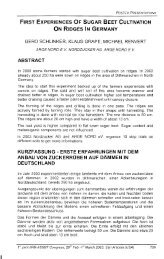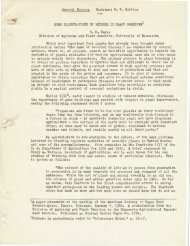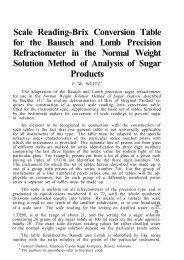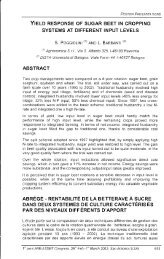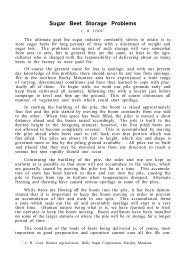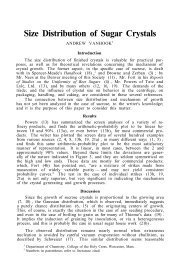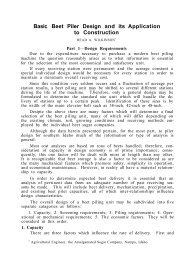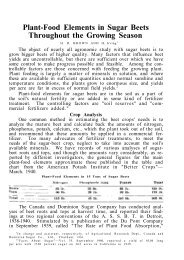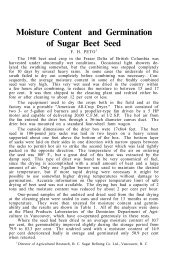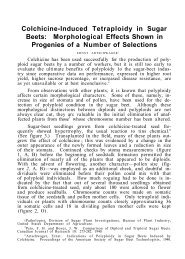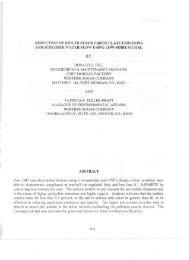New generation of molasses chromatographic separators using ...
New generation of molasses chromatographic separators using ...
New generation of molasses chromatographic separators using ...
Create successful ePaper yourself
Turn your PDF publications into a flip-book with our unique Google optimized e-Paper software.
<strong>New</strong> Generation <strong>of</strong> Chromatographic Separators Using the FAST Technology<br />
Hannu Paananen, Finnfeeds Finland Ltd, 02460 Kantvik, Finland, and Franyois Rousset,<br />
Applexion, Inc., 606 Potter Road, Suite 300, Des Plaines, IL 60016.<br />
1 Abstract .<br />
Over the past 4 years the F.A.S.T. Separation Teclmology has brought the <strong>chromatographic</strong><br />
separation <strong>of</strong> <strong>molasses</strong> a big step forward. The multi-pr<strong>of</strong>ile F.A.S.T. technology <strong>of</strong>fers up to 100<br />
% better column efficiency than the classical single pr<strong>of</strong>ile 5MB technologies. The better efficiency<br />
can be used to enhance separation results like product purity and product recovery or it can simply<br />
be used to enhance throughput. The system is easy to retr<strong>of</strong>it into existing installations. <strong>New</strong><br />
installations are possible to be built with significantly reduced resin inventory and therefore also<br />
significantly lower investment.<br />
This paper compares the performance <strong>of</strong> the multi-pr<strong>of</strong>ile F.A.S.T. technology to other existing<br />
systems and reviews the most recent projects in the world. Upgrading possibilities for classical<br />
5MB-systems are outlined.<br />
2 Introduction<br />
Chromatographic separation is a widely used tool in the sugar industry. The first industrial<br />
applications in the 60's and 70's used batch systems. D. Broughton et al. l patented the first 5MB<br />
system in 1961, but it was initially used in petrochemicals. K. Yoritomi et al. 2, 3 developed the<br />
improved 5MB system in the late 70's. In the mid 80's the simulated moving bed (SMB) was<br />
applied for the separation <strong>of</strong> <strong>molasses</strong>. In the late 80's the sequential 5MB emerged, which is<br />
especially suitable for recovering three or more fractions. T. Masuda et.a1. 4 presented in 1992 the<br />
<strong>New</strong> JO process, which is also capable <strong>of</strong> separating three product fractions. H. Paananen 5 covers<br />
the evolution <strong>of</strong>the different techniques in more detail in 1996, including an extensive reference list<br />
on industrial chromatography. F. Rousset and X. Lancrenon describe further development trends<br />
and new applications in 1997 6 , 7.<br />
Recent development includes the patented two-stage 8 and multi-loop systems 9 . The combination <strong>of</strong><br />
two or more <strong>chromatographic</strong> fractionators or the use <strong>of</strong> several circulation loops in a single system<br />
can be used to improve the efficiency <strong>of</strong> recovering mUltiple value-added products from the process<br />
streams <strong>of</strong> the sugar industry.<br />
G. Hyoky et a!. described in 1999 the remarkable new innovation, the multi-pr<strong>of</strong>ile FAST<br />
separation IO , which allows much higher capacity both for new installations and for retr<strong>of</strong>itting<br />
existing <strong>chromatographic</strong> <strong>separators</strong>.<br />
D. Paillat et.a!' compared several different 5MB systems in sweetener use ll .<br />
11~
3 Beet Based Raw Materials<br />
Beet <strong>molasses</strong> has been widely used as raw material in <strong>chromatographic</strong> separation plants.<br />
Typically beet <strong>molasses</strong> contains on dry substance basis about 60 % sucrose, 12 % inorganic salts,<br />
8 % organic acids, 5 % betaine, 2 % raffinose, 3 % amino acids, 0,12 % inositol and the remainder<br />
consists <strong>of</strong> hundreds <strong>of</strong> minor constituents. In addition to sugar it is also possible to recover other<br />
value-added by-products from <strong>molasses</strong> as described by H. Paananen et a1. 12 . So far the most<br />
significant value-added product is betaine.<br />
In some cases it may be preferable to use intermediate run-<strong>of</strong>fs or even thick juice in the<br />
<strong>chromatographic</strong> separator. H. Paananen et al. compares the potential disadvantages and benefits 13 .<br />
4 Comparing the Different 5MB Technologies<br />
As noted above various 5MB systems have been introduced over the years. The following table 1<br />
compares 4 5MB variations, which are commercially available.<br />
In the classical 5MB all process streams flow continuously. These streams are feed (F), desorbent<br />
water (W), raffinate (R), extract (E) and circulation (C) or loop (L). In the classical 5MB the<br />
system is always connected in a loop and there is no difference between the circulation and the loop<br />
steps. AU steps circulate material in the system connected in a loop. A high amount <strong>of</strong> dissolved<br />
material circulates in the system. Typically the fraction outlet flows are only a small part <strong>of</strong> the<br />
high circulation flow. In <strong>molasses</strong> separation the extract flow is 5 - 10 % <strong>of</strong> the circulation flow.<br />
Thus this system has an inherently low efficiency. Figure I presents a typical separation pr<strong>of</strong>ile for<br />
the classical 5MB.<br />
The system divides the components in the feed into two categories:<br />
1. Components, which flow faster than the simulated, bed movement. These fast components form<br />
the so-called "rafflllate" fraction.<br />
2. Components, which flow slower than the simulated bed movement. These slow components<br />
form the so-called "extract" fraction .<br />
This means that the classical 5MB can only provide two product fractions with good recovery and<br />
purity. It is, <strong>of</strong> course, possible to combine several classical 5MBs to provide separation into more<br />
than two fractions, but naturally this approach also multiplies the problems associated with the<br />
classical 5MB in comparison with the more advanced 5MB systems.<br />
There are several suppliers for classical 5MB systems. Some use relatively deep (8' - 10') resin beds<br />
and usually the system comprises eight resin compartments. The high pressure drop caused by the<br />
high circulation flow through the high resin beds limits the capacity <strong>of</strong> these systems. Therefore<br />
some suppliers believe in shallow (2' - 6') resin beds and in this case the number <strong>of</strong> resin<br />
compartments in a single system can be 10 - 20. It is, indeed, possible to reach higher capacities<br />
<strong>using</strong> shorter resin beds but the fraction purities remain poor even though the number <strong>of</strong> resin<br />
compartments is increased. The added mechanical complexity makes the systems more prone to<br />
valve and other mechanical failures . One supplier has gone so far that they have installed the<br />
compartments on a carousel in order to replace the on-<strong>of</strong>f valves with a rotary valve.<br />
117
TABLE 1: COMPARISON OF DIFFERENT 5MB SYSTEMS<br />
CLASSICAL 5MB IMPROVED 5MB NEWJO F.A.S.T. 2-P<br />
STEP 1 STEP 1 AND LOOP STEP 1 (F+W) STEP 1 STEP 2<br />
F1 F1 F1 F1<br />
E4 04 E4<br />
W5 F1 E10<br />
W6<br />
STEP 2 STEP 2 AND LOOP STEPS 2.. 10 (W) I STEP 3 I STEP 4<br />
W1<br />
B4<br />
R4<br />
STEPS 3 - 8 SIMILAR STEPS 3 AND 4 SIMILAR STEPS 3 - 10 SIMILAR STEPS 5 - 7 DIFFERENT<br />
CIRCULATION/FLOW RATES/PRESSURE DROP<br />
----HfGHiH-IG-HiHiGH-- -ME6(CfMiHiG-Hil':f(GH- ---H(GHiHiG-HiH-I-GH--- 1--LOwiME61-U-Mif"'-Eb.-<br />
CONTINUOUSLY FLOWING STREAMS<br />
- ---------.---. -._-.----_.--. ------------------------------ ---------.-------------------- ---------- -.--------------. ---<br />
F,W,E,R,C=L C W,F5,C C<br />
SEQUENTIALLY FLOWING STREAMS<br />
------------------------------ --------------.--------.------- ---.-----------.-------------- ----------------- ----------- -<br />
_ F, W, E, R, -'= F, E, B, L F, W , E, R, B, 0, L<br />
TYPICAL EXTRACT PURITY FROM 60 PURITY FINAL MOLASSES<br />
. ---- ------8~f0io-- --- ----. ------ --- -·9-1-O/~---- -- -- - --I - - - - - - - - - - - 92- -0/0--- --- -- -- -- -------- -93 -iii~ - -- -- --<br />
- -<br />
TYPICAL SUCROSE RECOVERY FROM 60 PURITY MOLASSES IN CWT/SH~TON<br />
------------------------------ ------------------------------ -------------------------- --- ------.-.-.- ------------.------<br />
7.04 (= 100 %) 7.36 (= 105 %) 7.51 (= 107 %) 7.66 (= 109 %)<br />
COLUMN VOLUME TO TREAT 500 TONS OF MOLASSES DAILY IN CUFT<br />
._---------------------------- --------.-------------- ------ ------------------------------ ---------.--.--------------.-_.<br />
30 000 22 000 25 000 18 000<br />
EQUIPMENT COMPLEXITY<br />
- ------- -. ~-=fl GH- -- -- --- - ---- ----- --COW-- -- -- ----.j ------- - -HiG-H--------- -- ----- -----LOW- ----------<br />
EQUIPMENT COST = INVESTMENT<br />
--------------.--.------------ ------------------.--.-------- --------------------.--------- ------------------------.------<br />
HIGH MEDIUM HIGH LOW<br />
CAPABILITY TO HANDLE MULTI-COMPONENT FEEDS LIKE MOLASSES<br />
--------------------------.--- -------------------------.---- -- ------------.------- ------ ------------------------------.<br />
POOR POOR GOOD GOOD<br />
NUMBER OF PRQDUCT FRACTIONS WITH GOOD RECOVERY AND GOOD PURITY<br />
------------------------------ ------------------------------ -----------------------------. ---------- -------.-----.- ----<br />
2 2 3 3 +<br />
118
In table 1, I have used the deep (9') bed variant for the classical 5MB, because the resin bed<br />
dimensions are roughly similar to F.A.S.T. design and it is easier to compare the systems with<br />
similar design. It is also relatively simple to convert a classical 5MB to use the F.A.S.T.<br />
technology.<br />
In the Improved 5MB the streams are not flowing continuously any more. Each step is now divided<br />
into two periods: one with the F, W, R, E and C streams flowing and one with just circulation<br />
stream flowing in a loop (L). The division <strong>of</strong> each step allows much more defined fraction cutpoints.<br />
Thus a.much simpler system <strong>of</strong> four beds can <strong>of</strong>fer comparable sucrose recovery and better<br />
purity than the classical 5MB. Feed and water are introduced to every bed and this feature makes it<br />
difficult to get more than two product fractions with good recoveries and purities. Figure 2 shows a<br />
typical separation pr<strong>of</strong>ile for the Improved 5MB system.<br />
In the <strong>New</strong> JO process the feed point is fixed. Feed is introduced sequentially once a cycle (= F, W,<br />
Rand E streams flowing). Simultaneously with the introduction <strong>of</strong> the feed a first extract fraction<br />
(E) and raffinate (R) can be taken from the system. In <strong>molasses</strong> separation this first extract would<br />
be preferably sucrose-fraction. During the other steps <strong>of</strong> the cycle only water is fed into the system<br />
and raffinate and second extract are taken out from the system. In <strong>molasses</strong> separation the second<br />
extract would typically be betaine-fraction. Each cycle comprises 10 steps (with 10 resin<br />
compartments in the system), out <strong>of</strong> which one step is the F + W step and the 9 other steps are just<br />
feeding water (W). These nine step are similar with the inlet and outlet points shifting downstream<br />
one column at a time after the step time has elapsed. Figure 3 shows a typical separation pr<strong>of</strong>ile for<br />
the <strong>New</strong> JO system.<br />
The above-mentioned 5MB systems operate with only one pr<strong>of</strong>ile in the system. The F.A.S.T. 2<br />
pr<strong>of</strong>ile process (patent pending) is an 5MB with two pr<strong>of</strong>iles moving in the system. Figure 4 shows<br />
a typical separation pr<strong>of</strong>ile for the F.A.S.T. 2-pr<strong>of</strong>ile system. When two pr<strong>of</strong>iles are separated<br />
simultaneously, the capacity doubles. The F.A.S.T. 2-pr<strong>of</strong>ile process is realized by <strong>using</strong> 7 - 15<br />
different steps during each cycle (in a system with 4 compartments). The existence <strong>of</strong> two pr<strong>of</strong>iles<br />
is proven by the fact that two raffinate fractions can be drawn out simultaneously. For example, in<br />
step 2 raffinate fraction is taken from columns 1 and 3 simultaneously. Only the C flow is<br />
continuous in this system. Both pr<strong>of</strong>iles move downstream continuously. The flows <strong>of</strong> the other<br />
streams are sequential.<br />
119
5 Industrial Experience<br />
So far 8 industrial plants have been designed or converted to use the F.A.S.T. 2P system. Two new<br />
industrial plants have been specifically designed and built to use the system, and commissioned in<br />
1999. Another large new industrial system is currently under construction.<br />
Furthermore this new process has been selected for up-grading 5 existing industrial plants, which<br />
were initially designed for single pr<strong>of</strong>ile 5MB processes. In all retr<strong>of</strong>its significant benefits have<br />
been achieved.<br />
For example, we recently converted 2 classical 5MBs in Japan to use the F.A.S.T. 2-P system. The<br />
following improvements were noted.<br />
1. Betaine recovery as third product fraction with 85 ..90 % recovery<br />
2. The purity <strong>of</strong> sucrose fraction increased by 3 .. 5 %-units<br />
3. The recovery <strong>of</strong> sucrose increased by 2 . .4 %-units to correspond with sugar in the bag recovery<br />
<strong>of</strong> 8,8 cwtlt calculated from 60 purity <strong>molasses</strong>.<br />
4. The overall capacity increased by 10.. 15 % (for both converted units together, and this increase<br />
is limited by bottlenecks elsewhere in the beet sugar plant)<br />
5. Pressure drop problems disappeared<br />
The conversion work included some minor piping changes plus, <strong>of</strong> course, the equipment needed to<br />
handle the new product fraction: betaine. The separation columns and the resin remain the same.<br />
The main change was the new cycle program with the steps needed to generate the two pr<strong>of</strong>iles in<br />
the old systems. Thus we can note that with exactly the same column hardware the performance<br />
increase is tremendous. Betaine separation as a third fraction would normally require about 15..20<br />
% more column capacity. In addition to this the throughput increased by 10.. 15 % and both the<br />
sucrose recovery and purity increased.<br />
6 Conclusions<br />
The most recent F.A.S.T. 2-pr<strong>of</strong>ile separation technology provides fundamental benefits in terms<br />
<strong>of</strong> <strong>molasses</strong> separation capacity, multiple-fraction separation, and product purity. These benefits are<br />
not limited to new <strong>molasses</strong> separation plants, but can also be extended to existing deep bed<br />
classical 5MBs . The significant improvements obtained after retr<strong>of</strong>ttting to the FAST 2-pr<strong>of</strong>ile<br />
technology make such an up-grade a very attractive investment.<br />
It can also be a definite option to resolve the pressure drop difficulties, which plague so many <strong>of</strong> the<br />
existing 5MB <strong>chromatographic</strong> separation systems.<br />
120
7 Figures<br />
FIGURE 1: CLASSICAL 5MB - STEP 1 <br />
F1 + W5 IN & E6 + R3 OUT (END) <br />
FIGURE 2: IMPROVED 5MB - STEP1 A <br />
F1 +W3 IN - 'E3+R2 OUT (END)
FIGURE 3: NEW JO - STEP 1 <br />
F1 + W6 IN E10 + R3 OUT (END) <br />
6 7 8 9 2 . 34 5 <br />
-~~<br />
"£2<br />
~~<br />
FIGURE 4: FAST 2P - STEP 2 START <br />
F1 IN R1 OUT & W2 IN R3 OUT & W4 IN E4 OUT <br />
122
8 References<br />
1. D.B. Broughton, e.G. Gerhold. (1961) Continuous Sorption Process Employing Fixed<br />
Bed <strong>of</strong> Sorbent and Moving Inlets and Outlets. USP 2,985,589<br />
2. K. Yoritomi, T. Kezuka, M. Moriya. (1981) Method for the Chromatographic<br />
Separation <strong>of</strong> Soluble Components in Feed Solution. USP 4,267,054<br />
3. K. Yoritomi, T. Kezuka, M. Moriya. (1983) Method for the Chromatographic<br />
Separation <strong>of</strong> Soluble Components in Feed Solution. USP 4,379,751<br />
4. T. Masuda, K. Sayama, T. Kamada, S. Oikawa. (1992). Production <strong>of</strong> Raffinose: A new<br />
Byproduct <strong>of</strong> the Beet Sugar Industry. British Sugar PIc. Sugar Tech 92<br />
5. H. Paananen. (1996). Trends in The Chromatographic Separation <strong>of</strong> Molasses, SPRl<br />
1996 Workshop on Separation Processes in the Sugar Industry<br />
6. X. Lancrenon. (1997). Innovative Separation Technologies: Developments <strong>of</strong> new<br />
Applications in the Sugar Industry <strong>of</strong>North America. A decade <strong>of</strong>steady progress<br />
between 1986 and 1996, 29 th Biennial Meeting <strong>of</strong>the ASSBT.<br />
7. F. Rousset. (1997). <strong>New</strong> Developments in Chromatographic Separation <strong>of</strong> Beet<br />
Molasses. British Sugar PIc. EuroTechLink 97.<br />
8. G. Hyoky, H. Paananen, H. Heikkila, K-E Monten, J. Kuisma. (1998). Fractionation<br />
Method <strong>of</strong> Sucrose containing Solutions. USP 5,795,398.<br />
9. H. Heikkila, G. Hyoky, J. Kuisma. (2000). A Method for the Fractionation <strong>of</strong> Molasses.<br />
USP 6,093,326.<br />
10. G. Hyoky, H. Paananen, M. Cotillon, G. Cornelius. (1999). Presentation <strong>of</strong> the FAST<br />
Separation Technology, 30 th General Meeting <strong>of</strong> the ASSBT.<br />
11. D. Paillat, M. Cotillon, (1999). Different industrial applications <strong>of</strong>continuous<br />
chromatography in the sugar industry and for the production <strong>of</strong> sugar derivatives,<br />
Detmold Starch Convention 1999<br />
12. H. Paananen, G. Hyoky, G. Cornelius, M. Cotillon. (1999). Multiple Value-Added<br />
Products Using the FAST Separation Technology, International Conference on Value<br />
Added Products by the Audubon Sugar Institute in Baton Rouge, April 1999.<br />
13. H. Paananen, J. Kuisma. (2000). Chromatographic Separation <strong>of</strong>Molasses<br />
Components, A VH Association - i h Symposium in Reims, March 2000.<br />
123



